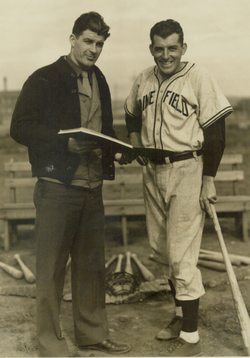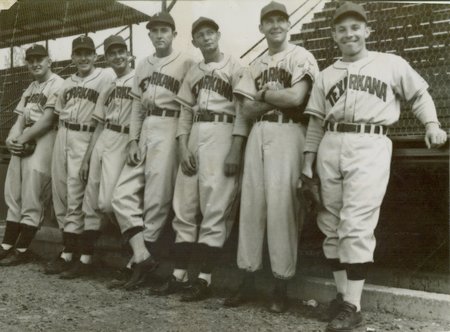Go on, why not sponsor this page for $5.00 and have your own
message appear in this space.
Click here
for details
|
Click here for details
 Steve
Sakas
Steve
Sakas
Date and Place of Birth:
May 13, 1921 Chicago, Illinois
Died: November 5, 2012 Skokie,
Illinois
Baseball Experience:
Minor League
Position:
Pitcher
Rank: Unknown
Military Unit:
119th Infantry Regiment, 30th Infantry Division US Army
Area Served:
European Theater of Operations
Steve Sakas dreamed of being a big league
pitcher. When he hurt his arm he lived his dreams through the
hundreds of youngsters he taught to pitch.
 Steven
P. “Steve” Sakas was born in
Chicago,
Illinois on May 13, 1921. He was a
multi-sport athlete at Amundsen High School and attended Wright Junior College
where he struck out 15 consecutive batters in one game.
Steven
P. “Steve” Sakas was born in
Chicago,
Illinois on May 13, 1921. He was a
multi-sport athlete at Amundsen High School and attended Wright Junior College
where he struck out 15 consecutive batters in one game.
Despite interest from the Chicago White Sox, Sakas went to Western
Michigan in Kalamazoo on a baseball scholarship, but
within a year he signed with the White Sox for $75 a month and a
$500 bonus. Sakas played his rookie year with the Lubbock Hubbers of
the Class D West Texas-New Mexico League in 1941. But it wasn’t only
the beginning of a playing career, it was also the start of a
lifelong dedication to teaching others to play ball.
"I was 13 that summer," recalls Bill Cope, who was a young
ballplayer in Lubbock in 1941. "We had a
sandlot baseball league of four or five teams and played on a field
across from the old Texas Tech gymnasium. Somehow, Steve Sakas and
another Hubber, Gene Stack, learned about the games and started
coming there some afternoons when they were in town and watched and
encouraged us and gave us some pointers. We thought this was great
because these were real professionals and our idols and we were at
the ball park for just about every Hubbers' game."
The West Texas-New Mexico League was a notorious hitters’ paradise
at the time and Sakas’ 9-18 won-loss record and 4.25 ERA looks a lot
worse that it was. In 1942, he moved up to the Superior Blues of the
Class C Northern League where he was 9-12 with a 3.96 ERA.
|

|
|
Steve Sakas (right) with the Lubbock
Hubbers in 1941. On the left is the Hubbers' first baseman
Kauzlerich.
|
Sakas was
forced to put his career on hold when he entered military service at
the end of the 1942 season. He was inducted at Fort
Sheridan, Illinois and took basic training with the Army Air Corps
at Miami Beach
as a physical instructor. Sakas was then assigned to Hammer Field, a
4th Air Force training base, near
Fresno,
California. From there he was
relocated to Ephrata Army Air Base in
Washington, where he coached the baseball
team.
|

|
|
Steve Sakas (right) with Herm Reich at
Gray Field, Washington
|
As the war progressed, every able-bodied man was
needed for overseas service and Sakas quickly found himself in the
infantry. “We had a warrant officer who tried out for the baseball
team,” says Sakas. “He didn’t make the grade and I cut him from the
team, but he really got me back when he sent me to the Army. That
was the dumbest cut I ever made!”
Sakas was soon on his way to Europe aboard the Queen Elizabeth. He was briefly
attached to a replacement depot in England before being assigned to the
119th Infantry Regiment of the 30th Infantry Division. Not only did
Sakas find himself in the thick of the Battle of Bulge but he also
found out that he was the new bazooka man, even though he’d never
fired a bazooka in his life! “Do you know what beat the Germans?”
Sakas asked. “The thought of this crazy Greek coming at ‘em with a
bazooka!”
Sakas was with the 30th Division as they crossed the Rhine, then the
Ruhr, and captured Magdeburg on the Elbe
River on 17 April, 1945, where they
were forced to wait to allow the Russians to be the first in to Berlin.
Following the German surrender, Sakas got back to doing what he did
best, organizing sports and recreation for the troops, which
included a softball team. One day, Colonel Stewart asked Sakas if he
could put together a baseball team. Another division had a hot team
that included Billy Johnson of the Yankees and were looking for games.
Sakas told the Colonel he didn’t have any baseball players but he’d
do his best. He held tryouts among his softball players and selected
the best, including the company cook, who became the team’s catcher
and always ensured Sakas had the best steak whenever he wanted.
The next step was to find somewhere to play. Sakas requisitioned a
large mansion house and grounds in the German town of Schleiz,
assuring the family that his players would take great care of
everything. He then set about finding uniforms and approached a
German dress factory which just happened to be owned by the family
who owned the house his baseball team had taken over. While the
factory started making uniforms, Sakas approached a cobbler, who
made baseball spikes following the ball player’s careful
instruction. “They looked great but they must have been the heaviest
spikes in the world!” recalls Sakas.
 Caps
were next on the list and Sakas had these made by a German
manufacturer who decided to use cardboard for the peak inserts.
“Just like the spikes,” says Sakas, “the caps looked great, but we
would sweat a lot and the cardboard peaks would just flop down in
our faces while we were playing.”
Caps
were next on the list and Sakas had these made by a German
manufacturer who decided to use cardboard for the peak inserts.
“Just like the spikes,” says Sakas, “the caps looked great, but we
would sweat a lot and the cardboard peaks would just flop down in
our faces while we were playing.”
Sakas was getting a dozen baseballs sent every month by Bill DeWitt,
owner of the St. Louis Browns, but balls were always in short supply,
and some German women even tried making these – the experiment was a
disaster and ended very quickly.
Dressed and ready to go, Sakas’ ball team christened their home
ground Colonel Stewart Field and played a number of games including
a heartbreaking, 1 to 0, loss to Sam Nahem’s All-Stars who went on
to be the European Theater champions. Nahem asked Sakas to come and
play for his team in Rheims,
France, but
Sakas was more interested in getting home to the States and picking
up where he left off with his baseball career.
He was back home by November 1945. “I went to spring training with
the Milwaukee Brewers in 1946,” recalls Sakas. “They felt I wasn’t
ready and sent me to Greenville, South Carolina.”
 Sakas
only spent a short time with Greenville
and joined Vicksburg of the Southeastern League where he
was 5-4 with a 3.89 ERA. In 1947, he went to spring training with Shreveport of the Texas League and was assigned to Texarkana of the Big State
League for the rest of the year, where he had a career-year. Sakas
was 13-5 during the regular season and won another two games in the
playoffs. His career looked to be on the right track. He was back
with Shreveport in 1948, won his first start against Oklahoma City,
9-4, on April 29, then beat Dallas, 3-1, on May 4. But a shoulder
injury brought everything to a sudden halt. He simply couldn’t throw
without pain and held out for the rest of the season before retiring
from pro ball.
Sakas
only spent a short time with Greenville
and joined Vicksburg of the Southeastern League where he
was 5-4 with a 3.89 ERA. In 1947, he went to spring training with Shreveport of the Texas League and was assigned to Texarkana of the Big State
League for the rest of the year, where he had a career-year. Sakas
was 13-5 during the regular season and won another two games in the
playoffs. His career looked to be on the right track. He was back
with Shreveport in 1948, won his first start against Oklahoma City,
9-4, on April 29, then beat Dallas, 3-1, on May 4. But a shoulder
injury brought everything to a sudden halt. He simply couldn’t throw
without pain and held out for the rest of the season before retiring
from pro ball.
Sakas worked with his father in the family tavern business and
bought his own place on Rand Street in Des Plaines, called Steve’s
Lounge (which he owned until his retirement in 1986). In 1970, he
had the honor of having a street named after him in Des Plaines. Sakas Drive is a small street running
alongside his old bar.
|

|
|
The Texarkana pitching staff in 1947.
Sakas is second from left
|
But Sakas wasn’t through with baseball. He continued to pitch, when
his arm would allow, and hurled for the semi-pro Michigan City Cubs
of the Michigan-Indiana League in 1949. He also scouted for the White Sox and Milwaukee Brewers. In 1951, he formed
the AHEPA All-Stars, a collection of Greek-American ballplayers. The
team had great success in semi-pro leagues. Sakas was also
player-manager for the semi-pro Skokie Indians in the late 1950s and
1960s.
During the 1970s, Sakas was a pitching coach with high school and
college kids. He served as the pitching coach for the Lincolnwood
Big League All-Stars youth team which won the World Championship in
Florida
in 1973. He served as pitching coach for the Niles West Indians in
the mid-1970s when they won two AA State Championships.
During the 1980s he coached the pitching staff of the semi-pro
Maryville Shamrocks and the Barnstormers, who won the AABC Illinois
state title two years in a row.
In the late
1980s he served as pitching coach for Northeastern
University and began giving lessons at
the Grand Slam USA Baseball Academy in Palatine.
At 87 years old, he
was still
teaching pitchers to throw. He firmly believed in teaching control
and for pitchers to master the fastball, curve and change up. He
won’t teach a kid how to throw a slider or a circle change. “Those
pitches are too hard on your elbow,” said Sakas who knows too well
the devastating effects of a pitching injury.
And what about that shoulder injury he suffered
back in 1948? Well, Sakas suffered a heart attack in 1998. Talking
with his doctor one day, he mentioned how he used to play pro ball
and hurt his shoulder. The doctor offered to take a look at his
shoulder with an MRI scan and discovered that he’d torn his rotator
cuff. “At 78, is it too late to make a comeback?” Sakas wondered.
Steve Sakas lived in Skokie, Illinois and
passed away, aged 91, on November 5, 2012. Just weeks before his
death, Sakas was able to see one of his baseball students, George
Kontos, pitch for the San Francisco Giants in the 2012 World Series.
This tribute to Steve aired on WGN TV Chicago in 2013
http://landing.newsinc.com/shared/video.html?freewheel=91046&sitesection=wgn_localnews&VID=24662017#.UVr-y-VfBux.email
Thanks to the late Steve Sakas who shared this information with me during a
telephone conversation in February 2008. Thanks, also, to his sons,
Jim and Peter, for helping with additional information and photos.
Created
April 2, 2008. Updated April 2, 2013
Copyright © 2013 Gary Bedingfield (Baseball in Wartime). All Rights
Reserved.


 Steve
Sakas
Steve
Sakas Steven
P. “Steve” Sakas was born in
Steven
P. “Steve” Sakas was born in 
 Sakas
only spent a short time with
Sakas
only spent a short time with 

